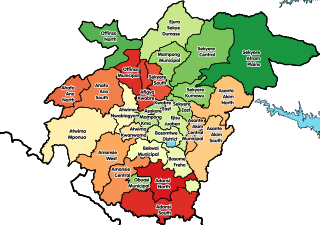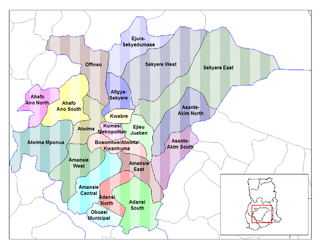Kumasi is a city in the Ashanti Region, and is among the largest metropolitan areas in Ghana. Kumasi is located in a rain forest region near Lake Bosomtwe, and is the commercial, industrial, and cultural capital of the historical Ashanti Empire. Kumasi is approximately 500 kilometres (300 mi) north of the Equator and 200 kilometres (100 mi) north of the Gulf of Guinea. Kumasi is alternatively known as "The Garden City" because of its many species of flowers and plants in the past. It is also called Oseikrom.
A mining accident is an accident that occurs during the process of mining minerals or metals. Thousands of miners die from mining accidents each year, especially from underground coal mining, although accidents also occur in hard rock mining. Coal mining is considered much more hazardous than hard rock mining due to flat-lying rock strata, generally incompetent rock, the presence of methane gas, and coal dust. Most of the deaths these days occur in developing countries, and rural parts of developed countries where safety measures are not practiced as fully. A mining disaster is an incident where there are five or more fatalities.
Adansi is the name of an Akan ethnic group inhabiting the Ashanti Region of Ghana. The capital of the Adansi is at Fomena. An Adansihene is still designated. The Adansi has seven paramountcies: the capital, Fomena, New Edubiase, Ayaase, Akrokyere (Akrokerri), Akrofuom, Bodwesango and, Dompoase. The Adansi is devolved into three local government divisions - Adansi South which has a population of 129,325 and an area of 1,380 square kilometres has the capital at New Edubiase; Adansi North has a population of 235,680, and an area 828 square kilometres and has its capital at Fomena; and Obuasi Municipal which has a population of 175,043 and is the second-largest urban settlement in the Ashanti Region and the eight biggest urban settlement in Ghana. Adansi South was once the largest cocoa growing area in the Ashanti Region.
The Ashanti Goldfields Corporation is a gold mining company based in Ghana that was founded by Joseph Ellis and Joseph Biney both from Cape Coast. The Ashanti Mine, located at Obuasi, 56 km south of Kumasi, has been producing since 1897. During the turn of the century 1900, the Ashanti Goldfields Corporation was among the most important gold mining companies listed at the London Stock Exchange. The mine is sited on one of the world's major gold deposits and is one of the ten largest in the world.

Gold mining is the extraction of gold by mining. World gold production was 3,612 tons in 2022.

Tarkwa is a town and is the capital of Tarkwa-Nsuaem Municipal district, a district in the Western Region southwest of South Ghana. Tarkwa has a 2013 settlement population of 34,941 people.

The Ashanti Region is located in southern part of Ghana and it is the third largest of 16 administrative regions, occupying a total land surface of 24,389 km2 (9,417 sq mi) or 10.2 percent of the total land area of Ghana. In terms of population, however, it is the most populated region with a population of 4,780,380 according to the 2011 census, accounting for 19.4% of Ghana's total population. The Ashanti Region is known for its major gold bar and cocoa production. The largest city and regional capital is Kumasi.

Obuasi is a gold mining community and town which is the capital of the Obuasi Municipal District in the Ashanti Region of Ghana. It lies in the southern part of the Obuasi Municipal, 39 miles south-west of Ashanti capital city Kumasi. Obuasi has a population of 175,043 people. Obuasi mining community has a mixture of the Ashanti people culture and the semi-island exclave Ashantiland.

Galamsey, derived from the phrase "gather them and sell", is local Ghanaian parlance that means illegal small-scale, gold mining in Ghana. Such workers are known as galamseyers or orpailleurs in neighboring Francophone nations. Galamseyers are people who perform illegal gold mining independent of mining companies, digging small working pits, tunnels, and sluices by hand. Galamsey is also referred to as Illegal Artisanal Small Scale mining (ASM).

Adansi North District is one of the forty-three districts in Ashanti Region, Ghana. Originally it was created from parts of two former districts on 17 February 2004: Adansi West District and Adansi East District; thus the remaining parts had been absorbed into parts of Obuasi Municipal District and Adansi South District respectively. On 15 March 2018, the southeast part of the district was split off to create Adansi Asokwa District. The district is located in the southern part of Ashanti Region and has Fomena as its capital town.

Obuasi Municipal District is one of the forty-three districts in Ashanti Region, Ghana. Originally it was formerly part of the then-larger Adansi West District in 1988, until part of the district was split off to create Obuasi Municipal District on 15 December 2003 ; whose remaining parts had been absorbed into parts of Adansi North District and Adansi South District respectively. Later, the eastern part of the district was split off to create Obuasi East District on 15 March 2018; thus the remaining part has been retained as Obuasi Municipal District. The municipality is the southern part of Ashanti Region and has Obuasi as its capital town.
Konongo is a gold bar mining and manganese mining community located in Ashanti, Ghana. The town serves as the capital of the Asante Akim Central Municipal. As of 2012, Konongo has a settlement population of 41,238 people. Konongo is about 53 kilometres (33 mi) from Kumasi, the Ashanti capital.
Abusua is the name in Akan culture for a group of people that share common maternal ancestry governed by seven major ancient female abosom (deities). The Abusua line is considered to be passed through the mother's blood . There are several Abusua that transcend the different ethnic subgroups outside of the ancient seven. People of the same Abusua share a common ancestor somewhere within their bloodline, which may go back as far as thousands of years. It is a taboo to marry someone from the same Abusua. The different Abusua are the Agona (parrot), the Aduana (dog), the Asenie (bat), Oyoko (falcon/hawk), the Asakyiri (vulture), the Asona (crow), the Bretuo (leopard), and the Ekuona (bull).
The Obuasi Gold Mine is an underground gold mine situated near Obuasi, in the Ashanti Region of Ghana. It was at one time one of the world's ten largest gold mines. The mine is in Obuasi Municipal District, 60 kilometres (37 mi) southwest of the regional capital Kumasi.

On November 12, 2009, a collapse occurred in an illegal, privately owned gold mine in Dompoase, Ashanti Region, Ghana. Up to 30 miners were prospecting the mine when it collapsed because of a landslide. At least 18 workers were killed in the collapse, including 14 women and the owner of the mine. Officials have described the disaster as the worst mine collapse in Ghanaian history.

The Ashanti economy refers to the economy of Ashanti Region in southern Ghana. It is largely self-sufficient, being driven by its service sector as well as by natural resources, being one of the world's top 10 largest gold-producers, and the second largest cocoa producer. The Ashanti region is also known for its production of manganese, bauxite and agricultural commodities such as cocoa and yam, with the region having low levels of taxation and without much need for foreign direct investment. The Ashanti region's industrial sector is characterised primarily by aerospace with automotive manufacturing and repair of motor vehicles and motorcycles (25.2%), manufacturing (10.5%), other service activities (6.3%) and accommodation and food service activities (6.0%). The Ashanti region spans an area of 24,389 km2, and according to the 2000 census, the region had a population of 3,612,950, most of whom (94.2%) were ethnic Akans, of whom 82.9% were ethnic Ashanti. The capital of the region is Kumasi, which with a population of 2,069,350 as of 2013 represents a high level of urbanisation within the state.

Freda Akosua Oheneafrewo Prempeh is a Ghanaian politician, and Member of Parliament in the Seventh Parliament and Eighth Parliament of the fourth republic of Ghana representing Tano North Constituency in the Ahafo Region, Ghana. She's currently the Minister of State, for the Ministry of works and housing, Ghana. She previously served as the Deputy Gender Minister and also Assembly member – "Assembly Woman" from 2002 to 2010 for the Lakoo Electoral Area of the La-Dadekotopo Constituency in the Greater Accra Region.
Adansi Asokwa is the capital of the Adansi Asokwa District in the Ashanti Region of Ghana. The district itself was created out of the Adansi North District by Legislative Instrument in 2018. It is located in the southern half of the region on the N8 highway running from Kumasi, capital of the region to Yamoransa near Cape Coast, capital of the Central Region. It is also the main town in the Asokwa Area Council, one of four in the district.
Bodwesango Senior High School is a mixed second cycle institution in Bodwesango in Adansi North District in the Ashanti Region of Ghana. In 2009, the school took part in the Inter-school debate under the topic: "Leaders are born but not made" where they emerged the first runner-up.
Dompoase Senior High School is a mixed second cycle institution in Dompoase in the Adansi North District in the Ashanti Region of Ghana.










